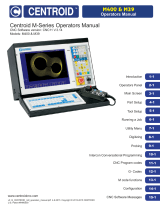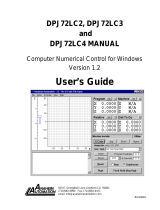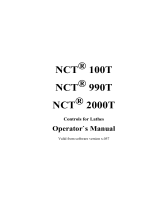
Operating manual (TC).
Quercus
CNC 8060
CNC 8065
·4·
REF. 2005
4.8.1 Basic operation. ....................................................................................................... 120
4.9 "Rounding between points" cycle................................................................................. 122
4.9.1 Basic operation. ....................................................................................................... 127
CHAPTER 5 CANNED CYCLES OF THE EDITOR. TAPPING.
5.1 Longitudinal threading cycle. ....................................................................................... 130
5.1.1 Basic operation. ....................................................................................................... 134
5.2 Taper threading cycle. ................................................................................................. 135
5.2.1 Basic operation. ....................................................................................................... 140
5.3 Face threading cycle.................................................................................................... 141
5.3.1 Basic operation. ....................................................................................................... 145
5.4 Thread repair cycle. ..................................................................................................... 146
5.4.1 Basic operation. ....................................................................................................... 152
5.5 Multi-entry threading cycle........................................................................................... 153
5.5.1 Basic operation. ....................................................................................................... 158
CHAPTER 6 CANNED CYCLES OF THE EDITOR. GROOVING.
6.1 Calibrate the grooving tool (location code, shape). ..................................................... 160
6.1.1 Outside longitudinal grooving................................................................................... 160
6.1.2 Inside longitudinal grooving. .................................................................................... 161
6.1.3 Face grooving. ......................................................................................................... 162
6.2 Simple longitudinal grooving cycle............................................................................... 163
6.2.1 Basic operation ........................................................................................................ 167
6.3 Simple face grooving cycle .......................................................................................... 169
6.3.1 Basic operation ........................................................................................................ 173
6.4 Inclined longitudinal grooving cycle. ............................................................................ 175
6.4.1 Basic operation ........................................................................................................ 180
6.5 Inclined face grooving cycle......................................................................................... 182
6.5.1 Basic operation ........................................................................................................ 187
6.6 Cut-off cycle................................................................................................................. 189
6.6.1 Basic operation ........................................................................................................ 192
CHAPTER 7 CANNED CYCLES OF THE EDITOR. PROFILES.
7.1 Point-to-point turning cycle. ......................................................................................... 194
7.1.1 Basic operation. ....................................................................................................... 200
7.1.2 Programming example............................................................................................. 201
7.2 Profile turning cycle. .................................................................................................... 202
7.2.1 Basic operation. ....................................................................................................... 208
7.2.2 Programming example............................................................................................. 209
7.3 ZC/YZ plane profiling cycle.......................................................................................... 215
7.3.1 Basic operation. ....................................................................................................... 219
7.4 Rectangular pocket cycle in the ZC/YZ plane.............................................................. 220
7.4.1 Basic operation. ....................................................................................................... 225
7.5 Circular pocket cycle in the ZC/YZ plane..................................................................... 226
7.5.1 Basic operation. ....................................................................................................... 230
7.6 Circular pre-emptied pocket cycle in the ZC/YZ plane. ............................................... 231
7.6.1 Basic operation. ....................................................................................................... 235
7.7 2D profile pocket cycle in the ZC/YZ plane.................................................................. 236
7.7.1 Basic operation. ....................................................................................................... 240
7.8 XC/XY plane profiling cycle. ........................................................................................ 241
7.8.1 Basic operation. ....................................................................................................... 245
7.9 Rectangular pocket cycle in the XC/XY plane. ............................................................ 246
7.9.1 Basic operation. ....................................................................................................... 251
7.10 Circular pocket cycle in the XC/XY plane. ................................................................... 252
7.10.1 Basic operation. ....................................................................................................... 256
7.11 Circular pre-emptied pocket in the XC/XY plane. ........................................................ 257
7.11.1 Basic operation. ....................................................................................................... 261
7.12 2D profile pocket cycle in the XC/XY plane. ................................................................ 262
7.12.1 Basic operation. ....................................................................................................... 266
CHAPTER 8 CANNED CYCLES OF THE EDITOR. LONGITUDINAL MACHINING.
8.1 Center punching. ......................................................................................................... 268
8.1.1 Basic operation. ....................................................................................................... 271
8.2 Drilling.......................................................................................................................... 272
8.2.1 Basic operation. ....................................................................................................... 275
8.3 Tapping........................................................................................................................ 276
8.3.1 Basic operation. ....................................................................................................... 278
8.4 Multiple center-punching.............................................................................................. 279
8.4.1 Basic operation. ....................................................................................................... 282
8.5 Multiple drilling. ............................................................................................................ 283

























